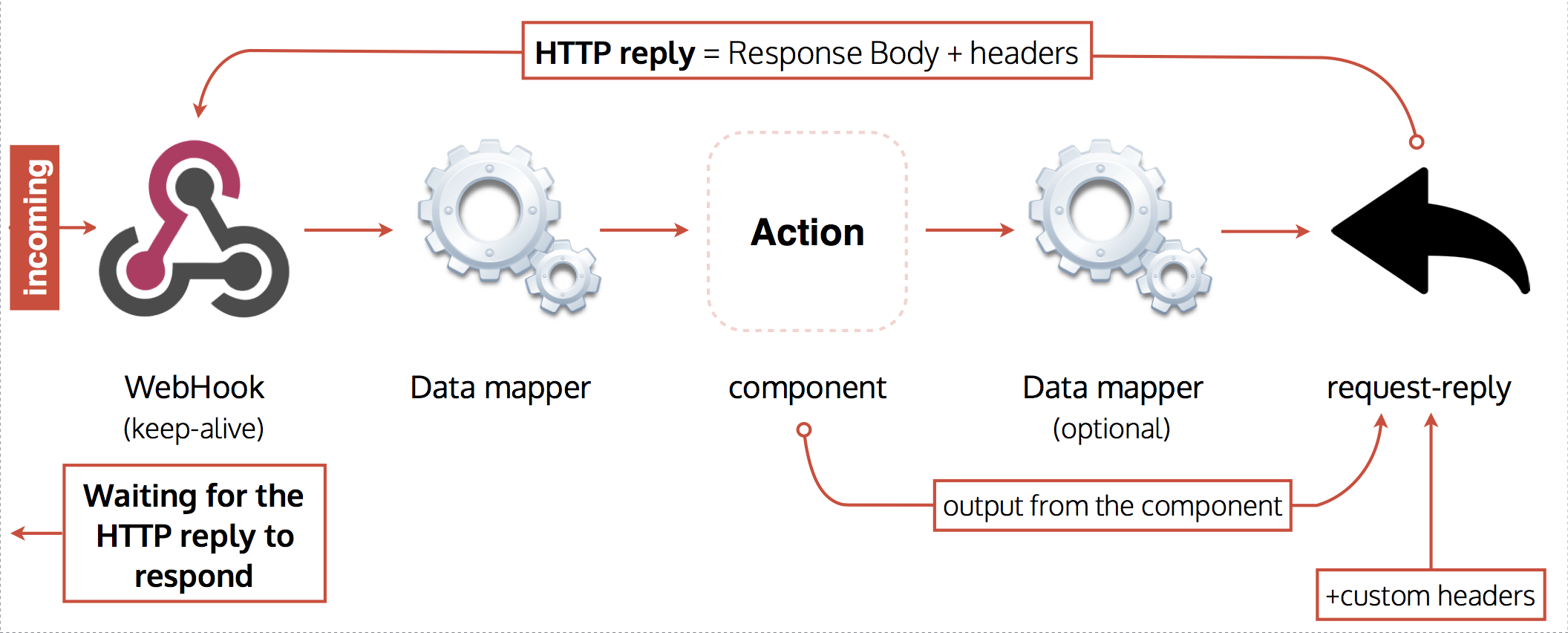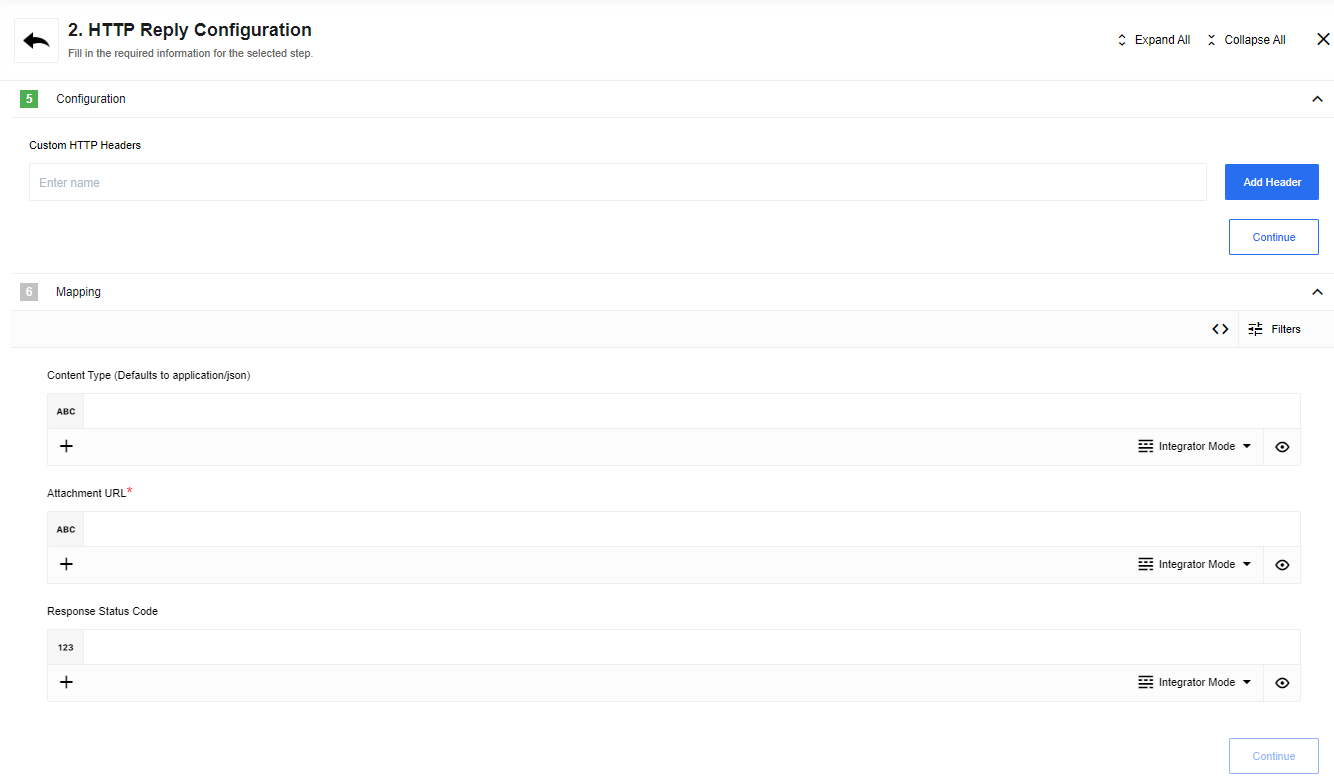HTTP Reply component
Description
This component receives the message body from incoming requests and, if a JSONata transformation is configured, applies it to the message. It then sends the transformed message back to the client that requested a webhook for a specific flow.
Authentication
This component requires no authentication.
Environment variables
Please Note: From the platform version 20.51 we deprecated the component
LOG_LEVELenvironment variable. Now you can control logging level per each step of the flow.
Technical Notes
The technical notes page gives some technical details about HTTP Reply component like changelog.
Asynchronous vs. Synchronous messaging
For some integration flow cases, a simple acknowledgement of the messaging receipt is sufficient, since this kind of transmission makes the message delivery more reliable and decouples the sender from the receiver (e.g., G. Hohpe & B. Woolf, 2009).
However, in many other cases, a two-way messaging conversation is a requirement. In this scenario, sender-receiver pair transforms into a requester and replier pair. Firstly the requestor sends a request message and waits for a reply message and then the replier receives the request message and responds with a reply message.
These two approaches are called: Asynchronous (one-way) and Synchronous (two-way) messaging transmission types. At elastic.io all integration flows are asynchronous in nature unless HTTP Reply component is added. It enables the two-way messaging conversation through the HTTP Reply pattern transforming the flow into a synchronous one.
Triggers
This component has no trigger functions. This means it will not be accessible to select as a first component during the integration flow design.
Actions
Reply
Configuration Fields
- Custom HTTP Headers - (string, optional): Provides with possibility to set additional headers separated by comma (e.g
Content-Language, User-Agent)
Input Metadata
- Content Type (Defaults to ‘application/json’) - (string, optional, defaults to
application/json): Header value tells the client what the content type of the returned content actually is. - Response Body - (string/Object, required): Body to send as the response
- Response Status Code - (number, optional, defaults to
200): Integer number between200and999(more info about status codes in rfc7231 standart)
If provided Custom HTTP Headers there will be additional field:
- customHeaders, contains:
- Header <header name provided in “Custom HTTP Headers”> - you can provide value to your custom header here
Output Metadata
The output metadata remains the same as the input metadata.
Reply With Attachment
Configuration Fields
- Custom HTTP Headers - (string, optional): Provides with possibility to set additional headers separated by comma (e.g
Content-Language, User-Agent)
Input Metadata
- Content Type (Defaults to ‘application/json’) - (string, optional, defaults to
application/json): Header value tells the client what the content type of the returned content actually is. - Attachment URL - (string, required): Link to file (on platform or external) that will be used as response
- Response Status Code - (number, optional, defaults to
200): Integer number between200and999(more info about status codes in rfc7231 standart)
If provided Custom HTTP Headers there will be additional field:
- customHeaders, contains:
- Header <header name provided in “Custom HTTP Headers”> - you can provide value to your custom header here
Output Metadata
The output metadata remains the same as the input metadata.
Use cases for HTTP Reply
The use-cases of HTTP Reply component are numerous. It can be used for simple cases of getting an answer from the flow upon the completion of the process till complex cases like:
- Checking the status of information from a Data Base on the availability of a record.
- Chatbots as a separate application.
- Communicator between elastic.io as backend and a third party mobile application as frontend.
Example: Advantage of Synchronous messaging
Here is a typical scenario: Integration flow is set to expect an incoming message via WebHook which is then processed further. The only acknowledgement that is given in this case is a simple Thank You from the WebHook, nothing more.
{
"requestId": "lv25ymyo15twhgp",
"message": "thank you"
}
The sender has no idea what have to happen with the message. If everything goes according to the plan, the message from outside would trigger the integration flow to execute without giving any verbose answer. This kind of communication is called asynchronous communication. However, what if you require a more meaningful response from the flow in order to process or execute something on your end? A simple thank you would not suffice here.
If you require to receive a meaningful, configurable response and immediately then it is better to use HTTP Reply in your integration flow. Here is a typical response from already configured request-reply two-way pattern:
{
"notification" :"A message was submitted by John Newman",
"subject" : "Sender used a subject Hello",
"email" : "Email was sent by john.newman@example.com"
}
HTTP Reply mechanism
In all of the use cases described above, the basic principle is the same: there is an incoming message which is passed through the integration flow for processing and a reply is sent back to the waiting entry point with on output information. Logic is the following:

-
Incoming message: the WebHook receives a payload in the correct and acceptable form which is then passed further. However, the WebHook is kept active or in keep-alive state and told to expect an HTTP reply before reporting back to the original sender of the payload.
-
The message is processed: the incoming message is mapped into the fields expected by the component and further processed by it. For a simplicity of the presentation, we have one component here but many more components can be here which would consequently process the incoming message through the different actions.
-
The message is delivered to request-reply: an outcoming data from the component (the last one in the chain) can be returned directly without mapping or, the mapping can be performed to have only the specific fields returned using the Response Body. At this stage, incoming fields from the component can also be mapped into the custom headers of choice.
-
Custom Headers can be added (optional): Custom headers can be added to further customise the returned message if it is required by the system which sent the original incoming message.
-
HTTP Reply is sent back: At this stage, the message is sent back directly to the first entry point, the WebHook in our case. The message contains the Response Body + headers.
Pre-requirements to use HTTP-reply
There are several specific requirements that need to be fulfilled before the request-response mechanism can be used. There are:
- If a custom Node.js component is to be used in the flow with HTTP Reply then then sailor-node.js version should be 1.3.0 or above to support the messaging in the flow. We recommend to use the most recent sailor version.
- If a custom Java component is to be used then please use
sailor-jvmversion 2.0.0 or above. - Care must be met to have all the steps tested in advance so the proper fields are mapped.
Click here to learn more about the elastic.io iPaaS

